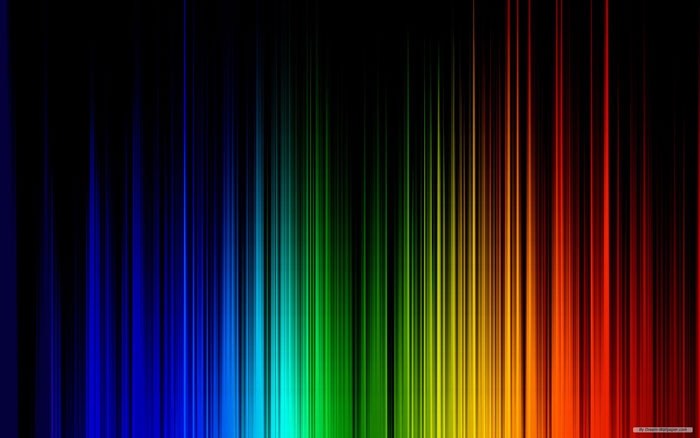
What is the Visible Light Spectrum?
The electromagnetic spectrum can be considered in terms of seven types of electromagnetic radiation, all corresponding to different wavelengths and frequencies: radio, microwave, infrared, visible light, ultraviolet, x-rays, and gamma rays. The visible light spectrum is the section of the electromagnetic spectrum which is visible to the human eye. The light in this section have wavelengths ranging from 380 nm and 760 nm.
Visible Light Spectrum
The visible light spectrum is often depicted as a scale of colors with different wavelengths. Sunlight, which is our primary source of visible light, and which is often referred to as white light, is actually the presence of all colors. Visible light travels at a speed of 300,000 km per second and can be broken down into seven colors. From longest to shortest wavelength, they are: red, orange, yellow, green, blue, indigo, and violet. To be clear, color is the eye’s perception of different wavelengths of electromagnetic light. Light, itself, does not possess color.
Properties of the Spectrum of Visible Light
Like any other form of electromagnetic radiation, visible light is subject to reflection, refraction, and diffraction.
- Reflection is the process by which a light wave comes into contact with a surface and is thrown back towards its source.
- Refraction is the change in direction a wave as a result of traveling from one medium to another.
- Diffraction is the process by which a wave spreads out as a result of passing through a narrow opening.
Light, Energy, and Color Temperature of Visible Light
The color of a light is determined by the energy being radiated by the light’s source. The wavelength of the energy being radiated determines the color we perceive the source to be. Imagine a perfect black body, which absorbs and radiates all the energy that reaches it. The hotter the black body gets, the greater the energy it radiates and the shorter the wavelength of that radiation. Our eyes interpret this light as the colors associated with shorter wavelengths, such as blue and violet.

Conversely, energy radiations with longer wavelengths are interpreted as the colors closer to red and orange. Incandescence is the phenomena when a body gets so hot that it begins to glow. The range of colors the eyes interprets from electromagnetic radiation of different wavelengths is commonly used to depict the visible light spectrum.
Experiments for Exploring the Visible Light Spectrum
There are lots of interesting and easy ways for you to explore the visible light spectrum. A great place to start is Newton’s prism experiment. With this experiment, Newton discovered that white light is a combination of all colors rather than a single color in itself.
Newton Prism Experiment
First, you’ll need a prism, a source of white light, and a white screen. On a flat surface, set up set up the prism and direct the white light through it. Position the white screen to receive the light as it exits the prism. On the white screen, you should see a rainbow. As we know, each color of the visible spectrum has a different wavelength and, therefore, is bent to a different degree as it passes through the prism. This property of light is what allows us to see the individual colors when the light exits the prism.
You can take this experiment a bit further. If you place a lens right in front of the screen and slowly move the screen away from the lens, the colors will combine back to a single white light. At this point, if you keep moving the screen away from the lens, the white light will separate back into the different colors but in the reverse order. If you move the screen back toward the lens, the colors will recombine to white, and then separate back into the constituent colors.
Optical Spectrometer
Another fun way to explore the visible light spectrum would be to make a simple spectrometer. An optical spectrometer is a scientific device used to split light into an array of its constituent colors. For this, you’ll need an old CD, a cereal box, a pair of scissors, aluminum foil, a 60 degree angle template, and tape.
- On the top of the box, use a straight edge to measure and mark off 1.5 inches along its length.
- Using the same straight edge, draw a guideline across the width of the box. Cut along the guideline, then unfold and cut off the flaps.
- From the corner of the box where the flaps were cut, draw a 3 inch line towards the center of the box on both sides.
- Using those lines as guides, cut two 3 inch slits on both sides of the cereal box.
- Insert the CD between the slits.
- Cut a rectangle on the opposite side of the box from where the CD was inserted. This rectangle should be half an inch from the top of the box, one inch high, and span the width of that side of the box.
- Cut enough aluminum for to cover the rectangle, then fold it in half. Align the crease with the center of the rectangular hole from the top and tape the other edge to the box.
- Cut another similar pieces of aluminum, fold and tape it from the bottom of the rectangle, leaving a 1mm slit between the two pieces of aluminum.
- Finally, tape the top of the box closed.
- Point the slit at any light source and look through the square hole. You should be able to see the rainbow colors.
Visible Light Spectrum and the Ecosystem
The visible light spectrum is a crucial part of the earth’s natural processes. The earth’s food chain depends heavily on it. Plants rely on visible light to power photosynthesis, the process by which they make food. Photosynthesis also produces oxygen and releases it to the atmosphere, making it available for human beings and other animals to breathe. Studies have also shown inadequate exposure to visible light causes brain damage and emotional illness in human beings.
Conversely, excessive exposure to the visible light can damage one’s eyes and skin. So, enjoy the wonders of visible light but, do so safely and responsibly.
Shop Rainbow Symphony Today
Need more ideas or equipment for creating an extraordinary light and color experience? Explore the collection of rainbow suncatchers, diffraction grating slides and diffraction glasses at Rainbow Symphony! Contact us today for any information on our products and services.



